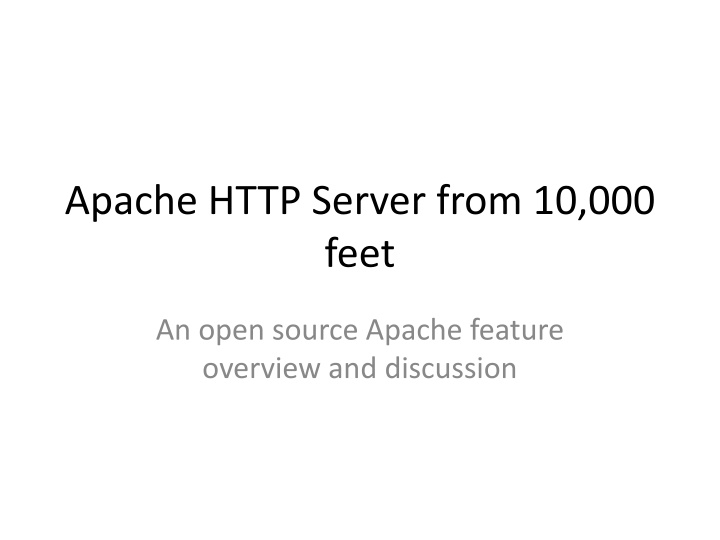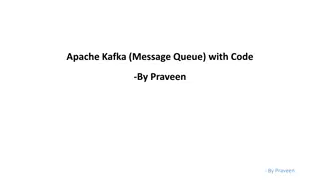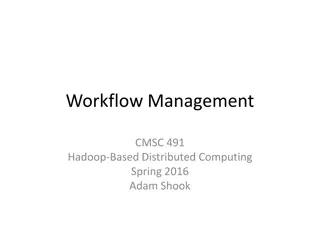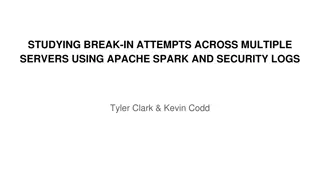
Apache HTTP Server: Features, Configuration, and Logs
Explore the Apache HTTP Server from its inception to advanced configurations, including module loading, log management, and troubleshooting. Learn about key features, version history, basic setup, and efficient usage for Linux and Windows environments.
Download Presentation

Please find below an Image/Link to download the presentation.
The content on the website is provided AS IS for your information and personal use only. It may not be sold, licensed, or shared on other websites without obtaining consent from the author. If you encounter any issues during the download, it is possible that the publisher has removed the file from their server.
You are allowed to download the files provided on this website for personal or commercial use, subject to the condition that they are used lawfully. All files are the property of their respective owners.
The content on the website is provided AS IS for your information and personal use only. It may not be sold, licensed, or shared on other websites without obtaining consent from the author.
E N D
Presentation Transcript
Apache HTTP Server from 10,000 feet An open source Apache feature overview and discussion
About Apache HTTP Server Founded 1995 built on NCSA httpd project Open Sourced 1999 version 1.3 Version 2 2000 add threading, compression, and openssl support Version 2.2 2005 - load balancing, authorization improvements Version 2.4 2012 - event mpm, memory optimization
The very basics Have a problem? Look at the Apache doc: http://httpd.apache.org/docs/2.4/ Download the newest version YES! It works on linux and windows Keep everything but docroot together in a custom directory, unless you re really used to where Linux stores things Start and stop with apachectl (easy) or httpd commands (more flexible & more than 1 apache install) Choose a worker Prefork (No threads, think php / perl), MPM (threaded), Event (Lots of simple traffic / keep alive) Modules extend Apache and can be dynamically loaded no need to compile them with Apache
Basic Configuration Have your httpd.conf contain only what modules you need to start up. Generally avoid <ifmodule> and know what you re loading Use additional conf files for additional features, and include them at end of httpd.conf: include conf/enabled*.conf. Files load in alpha numeric I use enabledX00_feature.conf Limit server information to world with ServerSignature Off ServerTokens Prod
Understand whats happing with logs http://httpd.apache.org/docs/2.4/mod/mod_log_config.html https://httpd.apache.org/docs/2.4/mod/mod_logio.html LogFormat ("%h %l %u %t \"%r\ ) (%>s) (%b) (\"%{Referer}i\ ) (\"%{User-Agent}i\ ) (%D) (%^FB) (%I) (%O) combined-with-IO LogFormat (Date/Time) (request status) (total bytes) (how we got here) (browser) (total request time) (First Byte time) (Incoming bytes) (Outgoing Bytes) Error logging, most verbose to least: traceX, debug, info, notice, warn, error, crit, alert, emerg
Virtual Hosting Allows Apache to run multiple domain names and / or listen on 80 and 443 Preferred way to use SSL SSL always requires a dedicated IP address, easily assigned in virtual host Can generally configure each virtual host separate from master httpd.conf and other virtual hosts. Useful for log names and locations for example. Modules inherited from other configuration files
Directing Traffic Control traffic to downstream servers, such as application servers Use mod_proxy (proxyPass) for simple traffic Use mod_rewrite (rewriteRule) for hybrid traffic control, URI changes, and HTTP to HTTPS translation. Use mod_proxy_balance for high availability traffic control.
Basic Security Control Allow / deny access in configurations with <location> Require (all / domain / IP) (granted / denied) .htaccess allows granular control of access and configuration by directory, but is also very slow. Ideal for distributed / multiple user / user administrator situations Multiple forms of authentication (user/pass) available, but not generally secure. Secure via application if possible and encrypt traffic with ssl.
Certificates with openssl Use newest version of Openssl see Heartbleed, BEAST, FREAK, Poodle . .. Self Sign certificates for testing and personal use Certs composed of csr (certificate signing request), key (private SSL key), .cer(certificate) Scan your site for free for vulnerabilities and compatibility with Qualys sslabs https://www.ssllabs.com/ssltest/
Its ALIVE! (and keeping it that way) High availability downstream with mod_proxy_balance http://httpd.apache.org/docs/2.4/mo d/mod_proxy_balancer.html Keep it sticky with sticky sessions Simple active / passive Apache with keepalived with VRRP http://www.keepalived.org/ Simple setup sample: https://raymii.org/s/tutorials/Keepaliv ed-Simple-IP-failover-on-Ubuntu.html
Appendix 1 - SSL generation script #!/usr/bin/perl -w die "usage: autogenSSLcert.pl [certname] [open ssl ver] [sslPasskey]\n" unless ($ARGV[0] && $ARGV[1] && $ARGV[2]); $certname = $ARGV[0]; $sslVer = $ARGV[1]; $sslPasskey = $ARGV[2]; $country="US"; $state="Maryland"; city="Silver Spring"; $org="Your Organization here"; $unit="Your subsidary / branch / etc here ; $email= webmaster@yourdomain.com ; print "Generating key for $certname\n"; system "/software/openssl/$sslVer/bin/openssl genrsa -out $certname.key 2048"; print "Generating key for $certname\n"; $cmdFileParams = "|/product/openssl/$sslVer/bin/openssl req -new -key $certname.key -out $certname.csr"; open(SSLGEN, "$cmdFileParams"); print SSLGEN "$country\n"; print SSLGEN "$state\n"; print SSLGEN "$city\n"; print SSLGEN "$org\n"; print SSLGEN "$unit\n"; print SSLGEN "$certname\n"; print SSLGEN "webmaster\@adpselect.com\n"; print SSLGEN "$sslPasskey\n"; print SSLGEN ".\n"; close (SSLGEN); print "creating self-signed cert for $certname\n"; system "/software/openssl/$sslVer/bin/openssl x509 -req -days 3650 -in $certname.csr -signkey $certname.key -out $certname.cer";
Appendix 2 Listing of config files enabled100dont_log.conf - things I don't log, like monitoring requests enabled200perf.conf - performance items, like mod_deflate enabled300status.conf - status page configuration enabled400custom_pages.conf - custom pages for 40X and 50X enabled500cgi.conf - CGI configuration to serve perl enabled600ssl.conf - SSL base configuration and modules Enabled800cluster.conf High Availability Clustering Configurations enabled901domain1_http.conf - domain1 HTTP enabled901domain1_ssl.conf - domain1 Ssl enabled902domain2_http.conf - domain2 HTTP enabled902domain2_ssl.conf - domain2 SSL enabled903domain1_http.conf - domain3 HTTP httpd.conf base configuration Magic - last resort file to help look at file and determine type mime.types describes file type
Appendix 3 Common rewrites # Turn On the RewriteEngine and Inherit all globally set rewrite rules RewriteEngine on RewriteOptions Inherit # Only allow REQUEST_METHOD GET and POST, deny all others RewriteCond %{REQUEST_METHOD} ^(TRACE|TRACK|DELETE|SEARCH|COPY|MOVE|PROPFIND|PROPPATCH|MKCOL|LOCK |UNLOCK|OPTIONS) RewriteRule .* - [F] # Ensure that a request is encrypted, unless . RewriteCond %{SERVER_PORT} !443 RewriteCond %{REQUEST_URI} !/static RewriteCond %{REMOTE_ADDR} !10. RewriteRule ^(.*)$ https://%{SERVER_NAME}%{REQUEST_URI} [L,R] # Proxy requests, unless they are images or css RewriteCond %{REQUEST_URI} ^/application(.*) RewriteRule !(\.gif$|\.jpg$|\.css$) http://appserver1:8080%{REQUEST_URI} [P]






















